
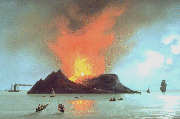 Hydrovolcanic eruptions are generated by
the intereaction of magma with either groundwater or surface water.
Explosive hydrovolcanic eruptions of basaltic lava are sometimes
called Surtseyan, after the eruption off Iceland
in 1963. Surtseyan eruptions are considered to be the "wet"
equivalents of Strombolian-type
eruptions, although they are much more explosive. This high
explosivity is a hallmark of hydrovolcanic activity. As the water
is heated, it flashes to steam and expands explosively, thus fragmenting
the magma into exceptionally fine-grained ash. When the volcanic
island of Surtsey was born in the Atlantic, the initial hydrovolcanic
eruptions were spectacularly explosive. As the volcano grew, however,
the rising lava in the central vent interacted with water to a
lesser degree, so that the waning stages of the eruption became
more Strombolian in character.
Hydrovolcanic eruptions are generated by
the intereaction of magma with either groundwater or surface water.
Explosive hydrovolcanic eruptions of basaltic lava are sometimes
called Surtseyan, after the eruption off Iceland
in 1963. Surtseyan eruptions are considered to be the "wet"
equivalents of Strombolian-type
eruptions, although they are much more explosive. This high
explosivity is a hallmark of hydrovolcanic activity. As the water
is heated, it flashes to steam and expands explosively, thus fragmenting
the magma into exceptionally fine-grained ash. When the volcanic
island of Surtsey was born in the Atlantic, the initial hydrovolcanic
eruptions were spectacularly explosive. As the volcano grew, however,
the rising lava in the central vent interacted with water to a
lesser degree, so that the waning stages of the eruption became
more Strombolian in character.
Hydrovolcanic eruptions are not restricted to the underwater development of oceanic islands. Many explosive Surtseyan events are generated on land by rising conduits (diapirs) of basaltic magma that interact with water-bearing strata (e.g., aquifers) at shallow levels beneath the surface. The two examples are shown here are from Ukinrek in Alaska and Capelinhos in the Azores.
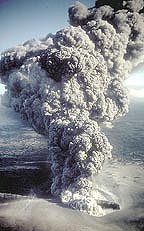
|
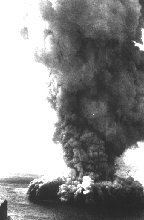
|
|
Ukinrek, Alaska (1977) |
Azores (1957) |
Note the radial cloud emanating from the
base of the Capelinhos eruptive column. This phenomenon is a 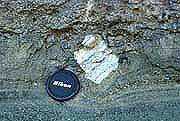 base
surge, a characteristic
feature of many Surtseyan-type eruptions. These surges are analogous
to the ring-shaped, ground-hugging clouds that travel radially
away from the vertical columns generated by nuclear explosions.
Base surges are derived from the gravitational collapse of the
"wet" eruptive column, which is denser than those associated
with "dry" eruptions. Base surge deposits are wedge-shaped,
with their thickest end near the vent. Dune-shaped deposits are
common near the vent, indicated lateral transport analogous to
the lateral movement and deposition of sand grains along the face
of a moving sand dune. The bedding is often disrupted by "bomb sags" containing
large ejected blocks which followed ballistic trajectories unrelated
to the lateral surge. Spherical accumulations of wet, accreted
ash, called accretionary
lapilli, are also common to many base surge deposits.
base
surge, a characteristic
feature of many Surtseyan-type eruptions. These surges are analogous
to the ring-shaped, ground-hugging clouds that travel radially
away from the vertical columns generated by nuclear explosions.
Base surges are derived from the gravitational collapse of the
"wet" eruptive column, which is denser than those associated
with "dry" eruptions. Base surge deposits are wedge-shaped,
with their thickest end near the vent. Dune-shaped deposits are
common near the vent, indicated lateral transport analogous to
the lateral movement and deposition of sand grains along the face
of a moving sand dune. The bedding is often disrupted by "bomb sags" containing
large ejected blocks which followed ballistic trajectories unrelated
to the lateral surge. Spherical accumulations of wet, accreted
ash, called accretionary
lapilli, are also common to many base surge deposits.
For more information on hydrovolcanic
deposits see Lava and Water.
For more information on the generation of base surges, see
Eruption Column
vs. Explosivity.
Hydrovolcanic explosions generate maars and tuff rings. These vent types are large circular depressions with low rims of ejected debris. Maars are excavated into the substrate, thus exposing older rocks along their inner walls. Tuff rings, however, are built above the substrate. Maars contain a greater proportion of fragmented basement rocks in the ejecta blanket. This suggests that maars are derived from steam blasts (phreatic eruptions) generated well above the diapiric intrusion. Tuff rings, on the other hand, contain a greater proportion of magmatic (juvenile) fragments (see for example, palagonite tuff). Such deposits are consistent with explosions derived from a combination of heated groundwater and vesiculating magma (phreatomagmatic eruptions) from relatively shallower intrusions.
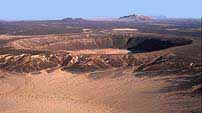
|
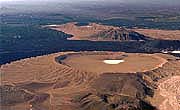
|
|
|
|
Ciruclar-shaped maars and tuff rings appear to be generated above rising columns of magma (diapirs). However, if the magma rises along a linear fracture zone, the interaction with groundwater may result in the reaming out of the fissure. Such eruptions can be even more destructive than those associated with maars and tuff rings, as exemplified by the highly explosive Tarawera eruption which buried three villages and killed 150 people on New Zealand's North Island in 1886.
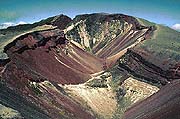
|
Rift zone generated by the 1886 hydrovolcanic eruption at Tarawera, New Zealand |
Although littoral cones have a hydrovolcanic origin, they are not true hydrovolcanic vents. They are composed of basalt tephra that accumulate as ejected debris from the explosive interaction of moving lava and seawater. Although pahoehoe flows generally enter the water in a relatively passive manner, a'a flows often enter the sea explosively to produce cone-shaped piles of ejected debris. The irregular cracks bounding cindery blocks of a'a allow water to penetrate into the interior of the hot flow where it then flashes to steam explosively. Basalt exiting from lava tubes can also generate littoral cones from episodic explosions due to disruption of the lava stream by incoming waves or swells. The littoral cones that develop from these explosive ejections are typically open on the seaward side.
|
||
|
explosive interaction of basaltic lava and seawater at Kilauea, Hawaii |